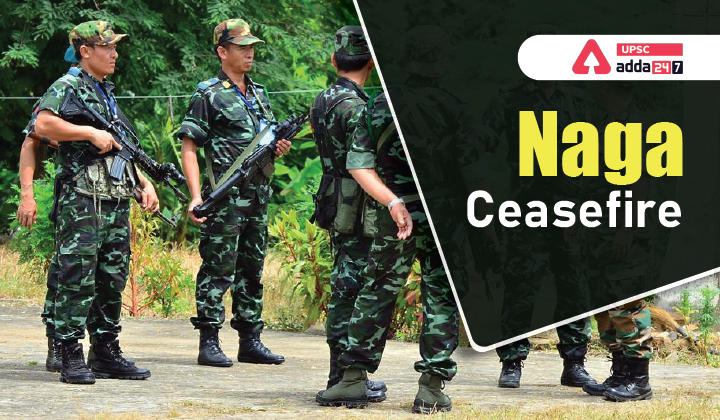Table of Contents
Naga Ceasefire Agreement-Relevance for UPSC Exam
General Studies III- Internal Security
In News
The National Socialist Council of Nagalim (Isak-Muivah) has rued the lack of progress in the Naga peace process after 25 years of signing ceasefire agreement with the Central government.
The Naga Political Issue
- The Britishers annexed Assam in 1826, and in 1881and the Naga Hills became part of British India. The formation of the Naga Club in 1918, which told the Simon Commission in 1929 “to leave us alone to determine for ourselves as in ancient times” was the first sign of Naga resistance.
- In 1946 the Naga National Council (NNC) declared Nagaland an independent state on August 14, 1947 though after India’s independence in 1947, the Naga territory was initially a part of Assam.
- The NNC resolved to establish a “sovereign Naga state” and conducted a “referendum” in 1951, in which “99 per cent” supported an “independent” Nagaland.
- On March 22, 1952, the Naga Federal Government (NFG) and the Naga Federal Army (NFA) were formed. The Government of India sent in the Army to crush the insurgency and, in 1958, enacted the Armed Forces (Special Powers) Act.
- In 1957, an agreement was between Naga leaders/groups and the Indian government amalgamated the Naga Hills region of Assam and the Tuensang frontier division to the northeast together under a single unit directly administered by the Indian government.
- Nagaland achieved statehood in 1963, though the rebel activities continued.
- The Naga groups include- Nationalist Socialist Council of Nagaland-NK (NSCN), Nationalist Socialist Council of Nagaland- Reformation (NSCN-R) and Nationalist Socialist Council of Nagaland-K-Khango (NSCN-K-Khango) and are breakaway factions of National Socialist Council of Nagaland (NSCN-IM) and National Socialist Council of Nagaland-Khaplang (NSCN-K).
The Naga Ceasefire Agreement
- The NSCN-IM (Isak-Muivah faction-extremist) signed a ceasefire agreement with the Centre in 1997 when the peace talks began.
- The Union government had signed a framework agreement with the NSCN-IM in 2015 to find a solution to the Naga political issue though the negotiations are yet to be concluded.
Features
- Interlocutor R.N. Ravi signed the agreement on behalf of the Centre in presence of PM Modi. The other two signatories were leader of NSCN(IM) i.e., Isak Chishi Swu, who died in 2016 and Thuingaleng Muivah (86) who is leading the talks.
- The Government of India recognized the unique history, culture and position of the Nagas and their sentiments and aspirations. The NSCN(IM) also appreciated the Indian political system and governance. Both sides agreed for concluding an accord in October 2019, which would settle all Naga issues
Significance
- It shows the governments strong intent to resolve the long-standing issue and adoption of diplomatic peaceful approach by Naga Society to fulfil their aspirations.
- The details of the agreement have not been made public by the government citing security reasons
- Despite of conclusion of successful talks on the government’s deadline of October 31, 2019, no accord was signed.
- The negotiations hit an impasse in 2020 with differences cropping up between NSCN-IM and interlocutor Ravi. Subsequently, NSCN-IM demanded the removal of Mr. Ravi as interlocutor.
Conflicting Stance
- The then Joint Intelligence Chief R.N. Ravi noticed the difference in understanding the Framework Agreement as was evident from the group’s insistence on a Naga constitution, and demand for a Greater Nagalimstretching beyond the boundaries of the present Nagaland state.
- In November 2017, Ravi signed an agreement with seven groups who had come together under the banner of the Naga National Political Groups (NNPGs), which did not include the NSCN (IM) which considers itself the principal representative of Naga aspirations and has been a rival of many of the NNPG groups. In a letter to Prime Minister Narendra Modi in 2020, the IM accused Ravi of attempting to “segregate the Naga civil society”.
- After becoming Nagaland Governor in 2019, Ravi accused NSCN (IM) for delaying the settlement by raising the contentious symbolic issues of separate Naga national flag and constitution.
- Ravi’s open criticism made the NSCN(IM) publicly harden its position with pushing the demand of Naga flag and Naga constitution as non-negotiable.
- NSCN(IM) claimed the framework agreement included the idea of unification of all Naga inhabited areas in Assam, Arunachal Pradesh, and Manipur and accused Ravi of twisting the document by deleting key words that suggested Nagaland would co-exist with India as a sovereign.
- This led to the demand of removal of Ravi which was eventually implemented.
Complexities in Nagaland Issue
- NSCN(IM) is in a delicate position and it is difficult to abandon the demand for a Greater Nagalim but India cannot accept that demand.
- Naga flag and Naga constitution which is one of the core demands of NSCN(IM) cannot be accepted by Indian Government given the abrogation of Article 370 (Special status to Jammu & Kashmir) in August 2019.
- Some demands that need discussion are
- Bicameral Assembly with at least 40 nominated members representing different tribes;
- Absorption of cadres as local armed forces or in the Indian paramilitary;
- Setting up of autonomous councils in Naga-dominated areas of neighbouring states;
- Use of the Naga flag for at least customary events.
What can be done?
- Any moves to alter boundaries will intensify ethnic conflicts and insurgencies beyond Nagaland and thus proper consultations and dialogues must be in line before taking any step further.
- The accord should be concluded only after consulting the states like Assam, Manipur and Arunachal Pradesh which have a stake in the matter.
- The Central government needs reiterate its commitment of finalizing the Naga accord while seeking to re-engage with the NSCN (I-M) without giving in to its arbitrary demands.




 TSPSC Group 1 Question Paper 2024, Downl...
TSPSC Group 1 Question Paper 2024, Downl...
 TSPSC Group 1 Answer key 2024 Out, Downl...
TSPSC Group 1 Answer key 2024 Out, Downl...
 UPSC Prelims 2024 Question Paper, Downlo...
UPSC Prelims 2024 Question Paper, Downlo...
